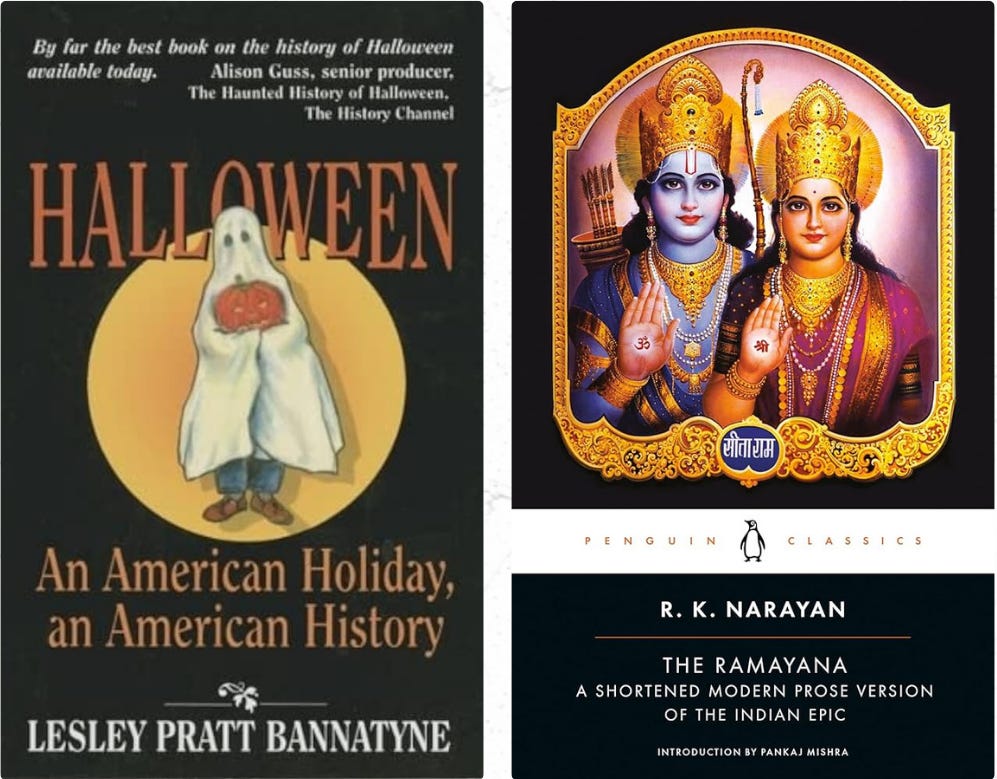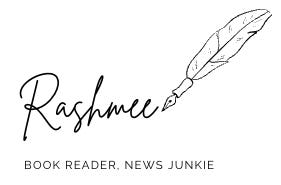Welcome to the Halloween and Diwali 2024 issue of This Week, Those Books, your rundown on books new and old that resonate with the week’s big news story.
Please consider supporting this news literacy effort by investing in a paid membership so that we can keep it freely accessible to our community of more than 10,000 subscribers in 114 countries.
If, for whatever reason, it’s not possible for you to upgrade to paid, email thisweekthosebooks@substack.com and we’ll give you full access, no questions asked.
🎧 Would you rather listen? The podcast – a human (not AI) read-along – drops at the weekend.
– Rashmee
The Big Story:
Halloween and Diwali coincide this year, prompting cross-cultural events in some parts of the world and twice the opportunities for commerce everywhere both festivals are celebrated.
From Antwerp to Birmingham to the Bay Area, from Durban to Georgetown, Guyana, the Hindu festival of lights is increasingly on the world’s calendar.
Like Halloween, Diwali is getting attention from big business.
Barbie has got its first ‘Diwali doll’, dressed in traditional Indian attire and makeup.
With South Asians considered one of the fastest-growing ethnic groups in the United States, US retail giants from Costco to Walmart have gone all in on Diwali this Halloween.
Some describe the 2024 twinning of Diwali and Halloween with creative mashups such as Diwaloween or Hallowali.
The growing prominence of Diwali in countries with expatriate Hindu communities raises the question: Could it properly take root in faraway soil, just as Halloween did in the United States in the late 19th century?
This Week, Those Books:
How Halloween, an import from far away, became an all-American feature.
The Hindu epic Ramayana remains a story for our times.
The Backstory:
This year’s coinciding of Diwali and Halloween is the first since 2016.
They coincide every few years because Diwali shifts around according to the lunar calendar, while Halloween is always on October 31.
Halloween rituals became a full-blown American holiday only because Irish immigrants to the US took their customs with them in the 19th century.
The story of King Rama and his wife Sita is central to Diwali, which celebrates the royal couple’s return home after 14 years in exile.
This Week’s Books:
Halloween: An American holiday, an American history
By: Lesley Bannatyne
Publisher: Pelican Publishing
Year: 1990
This book, by historian Lesley Bannatyne, is one of five she has written on Halloween. It’s a reminder of the impact new peoples can have on old places. Irish immigrants to the US transported their rituals, which allowed the creation of Halloween as an all-American holiday. It would go on to become a social, cultural and commercial feature of the American way of life. And it is now a huge export.
She covers Halloween’s 2,000-year history from its beginnings in the lands populated by Celtic peoples, now northern France, Ireland, England, Scotland, Wales and Brittany.
Originally a night that Celtic tribes communed with the spirits of the ancestral dead, the pagan celebrations were assimilated by the Catholic church after the Romans conquered the lands of the Celts. Bannatyne writes that the church provided Christian versions of the Celtic seasonal feast, also incorporating within them a Roman harvest celebration.
What’s particularly nice about this book is that it also provides recipes, poems and songs that relate to Halloween through the ages.
Choice quote:
“Wherever the Irish went – Boston, New York, Baltimore, through the Midwest to Chicago and beyond – Halloween followed along. Irish Halloween rituals met with similar rituals practiced by blacks, Germans, English and Scots and gained momentum throughout the second half of the 19th century. By the turn of the century, Halloween became a full-blown American holiday”.
The Ramayana: A shortened modern prose version of the Indian epic
By: R. K. Narayan
Publisher: Penguin
Year: 1977; 2006 edition with an introduction by Pankaj Mishra
The Ramayana is a great story – the triumph of good over evil, of light over darkness – and the late R K Narayan’s version remains as compelling as when it was first published nearly a half-century ago.
But this edition is noteworthy because of the nuanced introduction by Pankaj Mishra. At the outset, he writes, “Like millions of other [Indian] children, I first heard the story of Rama from my parents. Or so I think: I can’t remember a time when I did not know it”.
This is spot on. If your culture referenced Rama in some way, you didn’t have to be religious or even Hindu to know the story of the young king who is believed to be the ideal man and the ideal ruler. Rama is seen to epitomise duty, ethics, virtue, justice, courage, compassion and decisiveness.
But as Mishra makes clear, this is bardic literature and “the story of Rama has proliferated bewilderingly”, existing in all major Indian languages, as well as Thai, Tibetan, Laotian, Malaysian, Chinese, Cambodian, and Javanese. Many versions, he notes, “contradict one another, often self-consciously…The many Ramayanas also reflect the ideologies of their time: like most influential literature, The Ramayana has never been exempt from the struggles for political power”. One of these is the domination by elites or northern Indian upper castes. In the post-#MeToo era, attention has been focussed on “Rama’s cruelty to Sita at the end of his battle with Ravana [the demon king]”. Ravana had kidnapped Sita and Rama went to war to free her.
Mishra’s introduction does a brilliant job in pointing out why Narayan’s version is worth reading: “…so instinctively scrupulous and fair-minded is Narayan as a writer that not only Rama but also Ravana emerges as a fully rounded, even somewhat sympathetic, character. Though a dedicated sensualist, Ravana does not seem intrinsically bad or evil. Narayan shows clearly how he is led astray by greed, and then succumbs to the particular illusion of power: the dream of perpetual dominance”.
Think of our world today and it’s clear why The Ramayana remains a story for our times.
I hope you find This Week, Those Books useful, thoughtful, and…a conversation starter. It’s a small operation here at TWTB, and support from readers like you helps keep this news literacy project going.
Email thisweekthosebooks@substack.com to tell us what you think.
Connect with me on LinkedIn | Twitter | Bluesky | Facebook | Threads | YouTube






